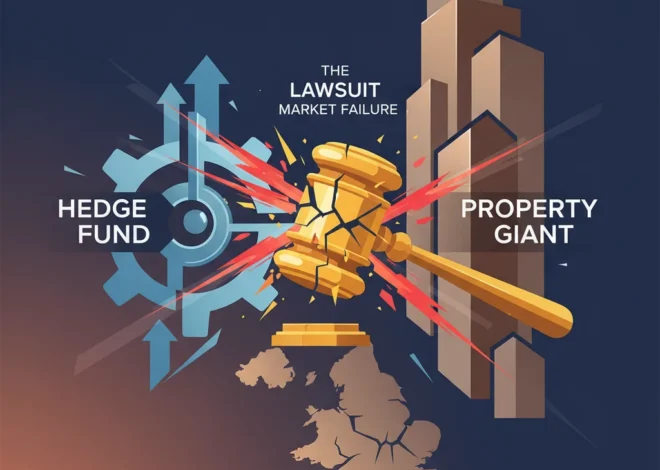
Liquid Assets: What Lakeside Living Teaches Us About Navigating Financial Markets
The allure is undeniable. As the Financial Times notes in its feature on “perfect lakeside living,” the combination of spectacular views, abundant wildlife, and intriguing shorelines creates a powerful pull. These properties represent more than just a home; they embody tranquility, stability, and a deep connection to the natural world. But what if this idyllic scene also holds a masterclass in navigating the often-turbulent waters of modern finance and investing?
At first glance, the serene surface of a lake seems worlds away from the frantic, data-driven environment of the stock market. Yet, the principles that govern a healthy lakeside ecosystem and the strategies required for successful wealth management share a surprising and profound symmetry. From understanding the terrain beneath the water to predicting the weather on the horizon, the lessons of lakeside stewardship offer a powerful framework for investors, finance professionals, and business leaders alike.
This exploration will delve into the parallels between the natural world and the financial one. We will see how the shoreline defines risk, how the water’s currents mirror market trends, and how the unseen depths represent the disruptive potential of financial technology. By viewing the complex world of economics and trading through this unique lens, we can uncover timeless strategies for building a resilient and flourishing financial future.
The Shoreline: Charting the Contours of Your Investment Portfolio
Every lake is defined by its shoreline. It can be a gentle, sandy beach, a rugged, rocky cliff, or a soft, marshy wetland. This boundary dictates how one interacts with the water and determines the stability of the surrounding land. In the world of finance, an investor’s portfolio has its own shoreline, shaped by their risk tolerance and strategic asset allocation.
A portfolio with a “sandy beach” shoreline might be heavily weighted towards low-risk assets like government bonds and cash equivalents. It offers easy access and low volatility but may not provide significant long-term growth. Conversely, a “rocky cliff” portfolio, dominated by high-growth stocks and speculative assets, has the potential for spectacular returns but also carries the risk of a steep, sudden drop. The most resilient ecosystems—and investment portfolios—often feature a diverse shoreline, blending different elements to create stability and opportunity.
This is the core principle of diversification in investing. By combining different asset classes—equities, fixed income, real estate, and alternatives—an investor can build a portfolio that weathers economic storms. Just as a varied shoreline prevents erosion, a diversified portfolio protects against the downside of any single market movement. The goal is to construct a foundation that is solid enough to support long-term goals without being so rigid that it cannot adapt to the changing economic climate.
The New Scramble for Africa: Why the US Just Dethroned China in a High-Stakes Investment Race
Reading the Water: Market Analysis in the Age of Fintech
An experienced sailor doesn’t just see a body of water; they read its surface for signs of what lies beneath and what is coming. The texture of the ripples, the color of the water, and the direction of the current are all data points that inform their decisions. Similarly, modern trading and investing rely on interpreting a vast sea of data to forecast market movements and identify opportunities.
Today, financial technology (fintech) has equipped us with unprecedented tools to “read the water.” Algorithmic trading platforms act like advanced sonar, pinging the market for patterns invisible to the human eye. AI-driven analytics can process global news, economic reports, and social media sentiment in real-time, much like a sophisticated weather modeling system predicting a coming storm. The fundamental principles of economics provide the chart and compass, but fintech provides the high-resolution satellite imagery.
Below is a comparison of how we might assess a natural lake versus a financial market:
| Lakeside Indicator | Financial Market Equivalent |
|---|---|
| Water Clarity | Market Transparency & Corporate Reporting |
| Current Speed & Direction | Market Momentum & Trend Analysis |
| Weather Forecast (Wind/Storms) | Volatility Index (VIX) & Geopolitical Risk |
| Water Temperature | Investor Sentiment (e.g., Fear & Greed Index) |
| Inflow/Outflow of Streams | Capital Flows & Monetary Policy |
Just as one wouldn’t set sail without checking the forecast, a modern investor shouldn’t enter the market without leveraging the powerful analytical tools that the fintech revolution has provided. These technologies don’t eliminate risk, but they transform it from an unknown variable into a calculated probability.
The Unseen Depths: How Blockchain is Reshaping Asset Ownership
The most intriguing part of any deep body of water is what you cannot see. The depths hold hidden structures, unique ecosystems, and untapped resources. For centuries, accessing this value was impossible. In the financial world, many high-value assets—like prime lakeside real estate, fine art, or private equity—have been similarly inaccessible, locked away in the illiquid depths of the market.
Blockchain technology is the deep-sea submersible that is changing this reality. Through a process called tokenization, blockchain can take an illiquid, indivisible asset and convert it into a series of digital tokens that can be bought, sold, and traded on a secure and transparent ledger. Suddenly, a multi-million-dollar lakeside villa doesn’t have to be owned by a single entity. It can be fractionally owned by hundreds or thousands of investors around the world.
This innovation is fundamentally disrupting traditional banking and investing. It democratizes access to previously exclusive asset classes and creates new forms of liquidity. The global market for tokenized assets is projected to reach $16 trillion by 2030, according to a report by the Boston Consulting Group. This isn’t a niche concept; it’s the future of how we define and trade value. By providing a transparent, immutable record of ownership, blockchain technology brings the clarity of the surface to the deepest, murkiest corners of the financial world.
The 50% Return No One is Talking About: A Deep Dive into the UK's Best-Kept Savings Secret
The Broader Ecosystem: The Interconnected Global Economy
No lake exists in a vacuum. It is part of a larger watershed, fed by rivers, influenced by regional weather patterns, and impacted by the health of the surrounding forests. An event miles upstream can drastically alter the lake’s chemistry and water level. This intricate web of connections is a perfect metaphor for the modern global economy.
A decision made by a central banking authority in one country can create ripples that become waves in markets on the other side of the planet. A supply chain disruption in a single region can affect industries globally. This interconnectedness means that a narrow, isolated view is no longer sufficient for effective financial strategy. Investors and business leaders must adopt an “ecosystem mindset,” understanding how shifts in politics, technology, and environmental policy interact with the principles of economics.
This is where a deep understanding of the broader economy becomes critical. Factors like interest rate changes by the Federal Reserve (acting as a dam controlling water flow), international trade agreements (the streams connecting different lakes), and technological breakthroughs (a new species changing the ecosystem) all have profound implications. The stability of our financial “lake” depends entirely on the health of the entire global economic watershed.
Stewardship: The Art of Long-Term Wealth Preservation
Finally, owning a lakeside property is not a short-term trade; it is an act of long-term stewardship. It involves preserving the asset, protecting the surrounding environment, and ensuring its value for future generations. This same philosophy should be the cornerstone of any sound investment strategy.
The rise of Environmental, Social, and Governance (ESG) investing reflects this shift in the financial world. Investors are increasingly recognizing that long-term value creation is intrinsically linked to sustainable and ethical practices. Companies that neglect their environmental impact, foster poor social policies, or operate with weak governance are, like a polluted lake, likely to see their vitality—and their stock market value—decline over time. The growth is staggering; global ESG assets are on track to exceed $53 trillion by 2025, representing more than a third of all professionally managed assets (source).
This long-term perspective moves beyond the daily fluctuations of trading and focuses on the enduring principles of value. It involves planning for succession, managing wealth across generations, and investing in a way that contributes to a stable and prosperous global economy. The ultimate goal is not just to profit from the system but to ensure the entire ecosystem remains healthy for decades to come.
The Ultimate Illiquid Asset: Deconstructing the ROI of a £100,000 'Gentleman Tutor' for a Baby
The quiet wisdom of a lakeside view offers more than just respite; it provides a blueprint for financial success. By understanding our shoreline of risk, reading the waters of the market with the help of financial technology, exploring the depths with new tools like blockchain, and acting as responsible stewards of the entire economic ecosystem, we can navigate our way to a future that is not only profitable but also sustainable and secure. The perfect lakeside property, it turns out, is a reflection of the perfect portfolio: balanced, resilient, and built to last.


